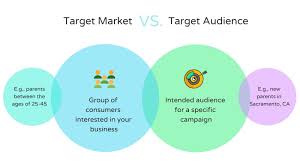Unlocking Success: Understanding Your Target Audience in Marketing
The Importance of Understanding Your Target Audience in Marketing
When it comes to marketing, one of the key factors that can significantly impact the success of your campaigns is understanding your target audience. Your target audience refers to the specific group of people that your products or services are aimed at. By identifying and comprehending the characteristics, preferences, behaviours, and needs of your target audience, you can tailor your marketing strategies to effectively reach and engage with them.
Why is Knowing Your Target Audience Important?
Understanding your target audience allows you to create more targeted and relevant marketing messages. By knowing who your audience is, you can speak directly to their interests, concerns, and aspirations. This personalised approach can help establish a strong connection with your audience and increase the likelihood of them engaging with your brand.
How to Identify Your Target Audience
There are several ways to identify your target audience. Conducting market research, analysing customer data, and creating buyer personas are common methods used by marketers to gain insights into their target audience. By collecting demographic information, psychographic data, and behavioural patterns, you can create a detailed profile of your ideal customer.
The Benefits of Understanding Your Target Audience
- Improved Marketing ROI: When you tailor your marketing messages to resonate with your target audience, you are more likely to see higher engagement rates and conversions.
- Better Product Development: Knowing the preferences and needs of your target audience can help you develop products or services that better meet their expectations.
- Enhanced Brand Loyalty: By understanding and addressing the concerns of your target audience, you can build trust and loyalty with customers.
- Competitive Advantage: A deep understanding of your target audience can give you a competitive edge by allowing you to differentiate your brand from competitors.
In Conclusion
In today’s competitive market landscape, understanding your target audience is crucial for the success of any marketing campaign. By investing time and resources in identifying and comprehending the characteristics of your ideal customers, you can create more effective marketing strategies that resonate with your audience and drive business growth.
Understanding and Engaging Your Target Audience: Key Questions Answered
- How do you define a target audience in marketing?
- Why is it important to identify your target audience in marketing?
- What are the benefits of understanding your target audience in marketing?
- How can market research help in identifying a target audience?
- What strategies can be used to reach and engage with a target audience effectively?
How do you define a target audience in marketing?
Defining a target audience in marketing involves identifying a specific group of individuals who are most likely to be interested in and benefit from your products or services. This process requires thorough research and analysis to understand the demographics, psychographics, behaviours, and preferences of this group. By defining your target audience, you can create tailored marketing strategies that effectively reach and engage with these individuals, ultimately driving better results for your business. Understanding your target audience is essential for delivering relevant messages that resonate with their needs and interests, leading to increased brand awareness, customer engagement, and ultimately, business success.
Why is it important to identify your target audience in marketing?
Identifying your target audience in marketing is crucial for several reasons. By understanding the demographics, preferences, behaviours, and needs of your target audience, you can create tailored marketing strategies that resonate with them. This personalised approach increases the effectiveness of your campaigns, leading to higher engagement and conversion rates. Knowing your target audience also helps in product development, as it allows you to design offerings that meet the specific requirements of your customers. Ultimately, identifying your target audience gives you a competitive advantage by enabling you to differentiate your brand and build lasting relationships with your customers based on trust and relevance.
What are the benefits of understanding your target audience in marketing?
Understanding your target audience in marketing offers a multitude of benefits that can significantly impact the success of your campaigns. By comprehending the characteristics, preferences, behaviours, and needs of your target audience, you can create more targeted and relevant marketing messages that resonate with them. This personalised approach not only establishes a strong connection with your audience but also increases engagement and conversion rates. Furthermore, knowing your target audience enables you to develop products or services that better meet their expectations, build brand loyalty, gain a competitive advantage, and ultimately drive business growth in a competitive market environment.
How can market research help in identifying a target audience?
Market research plays a crucial role in identifying a target audience by providing valuable insights into the demographics, preferences, behaviours, and needs of potential customers. Through market research, businesses can gather data on consumer trends, purchasing habits, and competitor analysis to create a comprehensive profile of their target audience. By analysing this information, companies can better understand who their ideal customers are and tailor their marketing strategies to effectively reach and engage with them. Market research helps businesses make informed decisions based on data-driven insights, enabling them to identify opportunities for growth and develop targeted campaigns that resonate with their target audience.
What strategies can be used to reach and engage with a target audience effectively?
When it comes to reaching and engaging with a target audience effectively, there are several strategies that marketers can employ. Firstly, conducting thorough market research to understand the demographics, behaviours, and preferences of the target audience is essential. By gaining insights into their needs and interests, marketers can tailor their messaging and content to resonate with the audience. Utilising data analytics and segmentation techniques can also help in targeting specific groups within the audience more accurately. Furthermore, leveraging various marketing channels such as social media, email marketing, content marketing, and influencer partnerships can enhance reach and engagement with the target audience. Personalisation of communication and offering valuable content or incentives can further strengthen the connection with the audience and drive desired actions. Ultimately, a combination of research-driven strategies, targeted messaging, multichannel approach, and personalised interactions can contribute to effectively reaching and engaging with a target audience in marketing campaigns.




